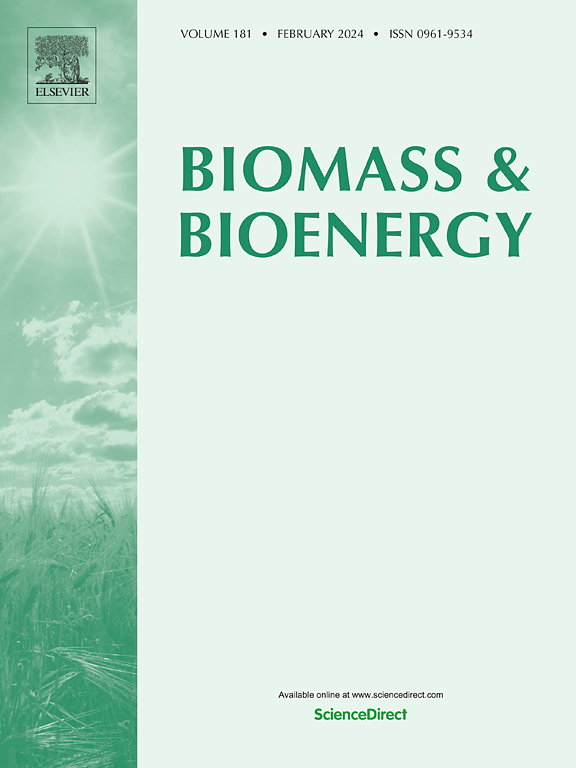Optimizing torrefaction of banana waste (peels and rachis) for sustainable biocoal production in rural communities
IF 5.8
2区 生物学
Q1 AGRICULTURAL ENGINEERING
引用次数: 0
Abstract
This study investigates the optimization of banana residue's torrefaction, specifically rachis and peel, by evaluating their potential as biocoal. This research aligns with circular economy principles, aiming to reduce waste and enhance the agro-industrial production chain. It also seeks to benefit small-scale farmers, particularly in remote areas without access to advanced technologies or biorefinery systems. Torrefaction conditions were optimized for biocoal quality and combustion emissions reduction using Response Surface Methodology, evaluating temperature (155–325 °C), time (12–68 min), and a 10 °C min−1 heating rate under an inert atmosphere. Analytical assessments included yields, proximate, ultimate and calorific (Higher Heating Value, HHV) analyses, and combustion emissions estimations (CO, CO2, and NOx). Results demonstrated solid yields ranging from 92.02 to 52.62 % for rachis and 91.92–56.46 % for peel, while HHVs ranged from 15.61 to 17.26 MJ kg−1 and 17.11–20.16 MJ kg−1, respectively. The optimized torrefaction conditions were 255 °C for 60 min for rachis and 249 °C for 20 min for peel. These conditions resulted in an SY of 63.21 % for rachis and 72.15 % for peel, with HHVs of 17.01 MJ kg−1 and 19.87 MJ kg−1 and ash content of 15.78 % and 14.92 %, respectively, suggesting greater energy yield for biofuel application. High ash content suggests the need for pre-treatment techniques or material blending to enhance the usability of biocoal as biofuel. CO2 emissions for the combustion of optimized biocoal were 1310.75 for peel and 1142.78 kg ton−1 for rachis, with the potential for reduced carbon intensity compared to conventional fuels.

本研究通过评估香蕉残渣作为生物煤的潜力,对香蕉残渣(特别是香蕉茎和果皮)的焙烧进行了优化。这项研究符合循环经济原则,旨在减少浪费和加强农工生产链。它还力求使小规模农户受益,特别是在无法获得先进技术或生物精炼系统的偏远地区。采用响应面方法对生物煤的质量和减少燃烧排放进行了优化,评估了温度(155-325 °C)、时间(12-68 分钟)和惰性气氛下 10 °C min-1 的加热速率。分析评估包括产量、近似值、最终值和热值(较高发热值,HHV)分析,以及燃烧排放估算(一氧化碳、二氧化碳和氮氧化物)。结果表明,果轴和果皮的固体产量分别为 92.02% 至 52.62%,91.92% 至 56.46%,而 HHV 分别为 15.61 至 17.26 兆焦耳/千克-1 和 17.11-20.16 兆焦耳/千克-1。优化的热解条件为:果柄 255 °C 60 分钟,果皮 249 °C 20 分钟。在这些条件下,果轴的 SY 值为 63.21 %,果皮的 SY 值为 72.15 %,HHV 分别为 17.01 MJ kg-1 和 19.87 MJ kg-1,灰分含量分别为 15.78 % 和 14.92 %,这表明生物燃料应用的能量产量更高。灰分含量高表明需要采用预处理技术或混合材料来提高生物煤作为生物燃料的可用性。燃烧优化后的生物煤炭,果皮的二氧化碳排放量为 1310.75 千克/吨,果穗的二氧化碳排放量为 1142.78 千克/吨,与传统燃料相比,有可能降低碳强度。
本文章由计算机程序翻译,如有差异,请以英文原文为准。
求助全文
约1分钟内获得全文
求助全文
来源期刊

Biomass & Bioenergy
工程技术-能源与燃料
CiteScore
11.50
自引率
3.30%
发文量
258
审稿时长
60 days
期刊介绍:
Biomass & Bioenergy is an international journal publishing original research papers and short communications, review articles and case studies on biological resources, chemical and biological processes, and biomass products for new renewable sources of energy and materials.
The scope of the journal extends to the environmental, management and economic aspects of biomass and bioenergy.
Key areas covered by the journal:
• Biomass: sources, energy crop production processes, genetic improvements, composition. Please note that research on these biomass subjects must be linked directly to bioenergy generation.
• Biological Residues: residues/rests from agricultural production, forestry and plantations (palm, sugar etc), processing industries, and municipal sources (MSW). Papers on the use of biomass residues through innovative processes/technological novelty and/or consideration of feedstock/system sustainability (or unsustainability) are welcomed. However waste treatment processes and pollution control or mitigation which are only tangentially related to bioenergy are not in the scope of the journal, as they are more suited to publications in the environmental arena. Papers that describe conventional waste streams (ie well described in existing literature) that do not empirically address ''new'' added value from the process are not suitable for submission to the journal.
• Bioenergy Processes: fermentations, thermochemical conversions, liquid and gaseous fuels, and petrochemical substitutes
• Bioenergy Utilization: direct combustion, gasification, electricity production, chemical processes, and by-product remediation
• Biomass and the Environment: carbon cycle, the net energy efficiency of bioenergy systems, assessment of sustainability, and biodiversity issues.
 求助内容:
求助内容: 应助结果提醒方式:
应助结果提醒方式:


